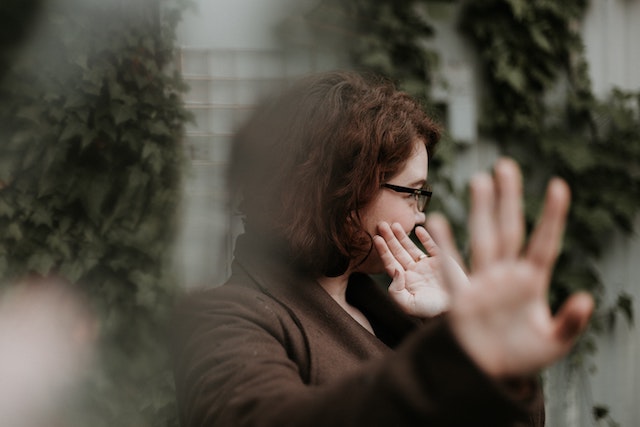No one wakes up one day and thinks, “Hmm, I can be pretty avoidant at times.” Coming to this realization can be a real slog, and often it’s only feedback from others that even gets us to think about what kind of attachment style we have. Relationships are where avoidant attachment dynamics are born, and intimate relationships in particular are where they manifest the most dramatically.
Avoidant Attachment Style 101: What You Need to Know
There are two types of avoidant attachment styles: anxious avoidant and dismissive avoidant.
Someone with a dismissive avoidant attachment style suppresses their need for emotional closeness — they’ve learned to dismiss or shut down their need/desire for connection. It’s a necessary outcome to a disappointing and painful childhood. At some point it starts to become clear that those who should be looking out for you aren’t going to be there in the ways you need them to. Under these circumstances, continuing to rely on them (or continuing to expect anything positive from them emotionally) becomes agonizing. So in order to cope with this unwanted reality, your mind shifts from: “I need others in order to survive/thrive” to: “I can only count on myself” and: “If you get too close to people, they will ultimately hurt you.”
This isn’t just a belief that someone with an avoidant attachment style holds; it’s a fundamental and pervasive way of navigating the world.
Someone with an anxious avoidant style has also experienced the painful absence of responsive caregivers. The anxious avoidant person, however, is more ambivalent than the dismissive avoidant. The anxious avoidant strives for independence but also feels the desire for closeness with others. Their need for attachment/connection continues to break through their avoidant armor.
When the anxious avoidant person creates a certain level of distance from others, their desire for emotional intimacy might intensify; and if the anxious avoidant person moves closer to someone emotionally, the very closeness they desired moments ago can suddenly feel smothering. The impulse to pull away now surfaces. In my therapy practice, I regularly hear some version of: “I can often feel overwhelmed by the needs of my partner, and this causes me to shut down or pull away” from individuals with an anxious avoidant attachment style.
Someone with an avoidant attachment style can often experience others as “too needy,” and this gives the avoidant person justification to pull away.

~~~
If you believe you have an avoidant attachment style, and if you’re trying to figure out whether you have more of an anxious or dismissive avoidant attachment style, don’t be surprised if sometimes it feels like you’re both anxiously and dismissively avoidant. There can be overlap between the two.
A friend recently said to me: “When I look back over the pattern of my relationships, I’ve heard from more than one person that I have difficulty ‘opening up’ or being emotionally vulnerable. This used to make me angry because it was usually said in frustration or as a jab during an argument. But after reflecting on this for quite some time, I’m now able to see that this feedback rings true.”
If you’ve been on the receiving end of such feedback, you know that it’s not easy to get to the place where you can admit that aspects of it are accurate
Reckoning with the avoidant attachment style label
Some of the factors that might lead you to conclude that you have an avoidant attachment style:
You’ve been told/asked over the years:
To be more vulnerable
Do you tend to hide your truest self from others? Do you make yourself fully known to others who are important to you? Have you felt (or been told by intimate partners) that you can be closed off emotionally? Do you cringe when your loved ones ask you to be “more vulnerable”?
To talk more
I’ve worked with many individuals in therapy who describe themselves as relatively quiet and somewhat shy. And because of this, it’s not uncommon for the people close to them to ask about what they’re thinking and feeling. They’ve reported that partners have said things like: “It’s like pulling teeth getting you to talk.”
To express your feelings
The feedback here is similar to the “talk more” request. “How do you feel about ______?” is a familiar question lobbed at those who aren’t naturally expressive and effusive about what they’re thinking. Although in many of our day-to-day dealings (especially in work environments), it’s not problematic to keep a lid on what’s going on for us emotionally, it can become a stumbling block in intimate relationships, especially if one partner expresses their feelings readily and is genuinely curious and interested in what their partner is feeling.
To be more present
You may have heard your partner asking you to “hold a space” and “be more present” for them. This may cause you to scratch your head and draw a blank.
Keep in mind that if you’ve become habituated to avoiding your own emotional life, it can sometimes feel like second nature to diminish or even dismiss the emotional life of others. For intimate relationships to work, both partners need to feel that there’s room for their thoughts and emotions. Asking your partner what they’re thinking or feeling—whether or not they need the prompting—sends a powerful message of caring and curiosity. Additionally, it can create a new habit for you, one of sharing your own thoughts and feelings with the person closest to you.
To show more interest
Along with being curious about your partner’s thoughts and feelings, you can make it a point to show more interest in all aspects of your partner’s life. If you have an avoidant attachment style, you may have been floored upon hearing your partner ask if you even love them. “How can you ask that?” you might say. “Of course I do! I say ‘I love you’ all the time.”
It’s important to remember that love is demonstrated not only in what we say, but in what we do. Loving acts are a complement to (not a substitution for) loving words.
What it feels like to have an avoidant attachment style
You may initially struggle with the question about whether you have an avoidant attachment style. You may be trying to figure out: Avoidant compared to what or whom?
Often, part of that struggle is twofold: Hearing that you hurt others by keeping them at arm’s length is difficult feedback to take in. And it can feel like it adds insult to injury if the feedback is delivered in what feels like an accusatory, critical way. Someone who doesn’t have an avoidant attachment style may assume that you’re intentionally being avoidant. Most of the time there isn’t any conscious intention towards avoidance.
If you have an avoidant attachment style, here are some things you might be thinking/experiencing:
“I often don’t know what I’m feeling”
If you’re in a relationship with someone who is anxiously or dismissively avoidant, it might be helpful to know the following: often, they don’t feel like they’re actively avoiding. Yes, they tend to need considerable time for themselves, and this might feel like avoidance to their partner, but often, the individual with avoidant attachment is not trying to shut their loved one out via that alone-time, but rather, recharging their own batteries.
it isn’t always easy for those with this attachment style to readily access their feelings, so when their partner asks, “What are you feeling?,” they might draw a blank.
Also, it isn’t always easy for those with this attachment style to readily access their feelings, so when their partner asks, “What are you feeling?,” they might draw a blank. They may not be feeling anything, or they might be totally cut off from their feelings. If the latter is true, it might be the result of spending years avoiding their feelings. And because of this inner avoidance, they no longer have easy access to what they’re thinking and feeling. In a relationship, this dynamic can feel as challenging to the non-avoidant partner as it is to the avoidant individual. And left as-is, it can undermine intimacy in the long run.
This is why it can be helpful for the partner of an avoidantly attached person to understand what’s underneath the blank stare they get when they’re asked what they’re feeling. (Or to speak more or share more or “open up emotionally.”) For some people with an avoidant attachment style, those urgings and those requests might sound like you’re speaking a different language. And of course, frustration can ensue for both of you.
“I am uncomfortable with the feelings of others”
You may find that you grow uncomfortable (perhaps even anxious) when people close to you express certain feelings. That might be—but not necessarily—because it’s hard for you to accept these feelings within yourself.
If you look back at your childhood and family of origin, you might consider whether your feelings reliably received attention. Perhaps feelings routinely seemed to take a backseat to practical issues (getting things done rather than discussing the emotional impact that events had on you and/or your siblings). Or perhaps expressing certain feelings led to unpleasant reactions from your caregivers, which would teach you to avoid expressing those feelings again.
“I minimize my own and other people’s needs”
By necessity, you may have learned to minimize the impact that certain experiences have on you. This would have helped you deal with stressful experiences beyond your control growing up. If your caregivers were unreliable or neglectful or abusive, you couldn’t allow yourself to fully feel how much you needed them. The need itself can feel crushing when you know it won’t be met. So you learned to turn the dimmer switch down on your interpersonal needs, on the impact your unreliable caregivers could have on you.
If your caregivers were unreliable or neglectful or abusive, you couldn’t allow yourself to fully feel how much you needed them. The need itself can feel crushing when you know it won’t be met.
The problem is that this gets carried forward to adulthood.
You may feel that you often don’t hurt because you don’t need (or you need little). You don’t allow yourself to experience the full extent of your needs. It’s common for individuals with this attachment style to report that they do not know exactly what they did to turn this part of themselves off and therefore they don’t know how to get it back online. As a result, they sometimes act or feel negatively when face-to-face with the needs of others. Others’ needs can feel like an inconvenience, like demands being foisted on them. In these moments, their knee jerk internal reaction is some version of: “Oh, come on, what’s the big deal?!”
This is a remnant of structuring your life to keep pain away. And the truth is, this no longer serves you, but it’s not easy to undo.
~~~
Every child has essential needs, and among the most important emotional needs are: the need to be seen and recognized; to be validated and acknowledged; to be cherished and delighted in; to be soothed and reassured. It’s not an understatement to say that when children don’t get those needs met, the trajectory of their lives beyond childhood are changed.
Often adults who did not get core psychological needs met as children have long ago abandoned the idea of ever getting those needs met, so the needs go underground. . .so deep underground that they cannot be felt or even recognized. Because of this, a relationship struggle can occur when they interact with someone who expresses need(s) similar to their own unmet, buried needs. It’s common to feel numb or angry in those moments, and those emotions are echoes of the pain that has been compartmentalized but that still exists somewhere within. Avoiding childhood wounds will not cause them to go away.
What does this ultimately mean?
If you are seeking to make your avoidant attachment style less automatic, an important step is to be mindful of all the ways in which you avoid discomfort. Leaning into discomfort can lead you to the parts of yourself that had to hide in order to get through childhood. These are the parts that carry the pain from the past, the parts of yourself you tend to avoid, the parts that get triggered in relationships. Avoidance of certain relationship dynamics stems from inner avoidance. Understanding this takes time and patience. But the benefits of those efforts can eventually turn the tide of a life lived through the protective stance of an avoidant attachment style.
~~~
Rich Nicastro, PhD., is a clinical psychologist with twenty-five years of experience based in Austin, Texas. Dr. Nicastro is credentialed through PSYPACT, which allows him to work with individuals and couples in many states. To check whether your state is among those approved jurisdictions, click PSYPACT.





